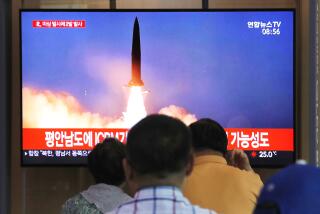Pentagon Study Uncertain of Risks of ‘Nuclear Winter’
- Share via
WASHINGTON — The Pentagon, in a report made available Saturday, said that the smoke and dust created by a nuclear war could block sunlight and lead to lowered temperatures, but that there is insufficient evidence to determine the length or severity of such a “nuclear winter.”
The report did not specifically challenge the theory, advanced in several scientific studies in recent years, that a nuclear exchange could damage the climate over an area much wider than that on which the weapons would have a direct impact.
The study acknowledged that the effects of a nuclear winter could be equal to, or even worse than, the more direct damage caused by the explosion of nuclear weapons.
But, it stated:
“We have very little confidence in the near-term ability to predict this phenomenon quantitatively, either in terms of the amount of sunlight obscured and the related temperature changes, the period of time such consequences may persist, or of the levels of nuclear attacks which might initiate such consequences. We do not know whether the long-term consequences of a nuclear war--of whatever magnitude--would be the often postulated months of subfreezing temperatures, or a considerably less severely perturbed atmosphere.”
Government Study Begun
The Pentagon was called upon to prepare the report, “The Potential Effects of Nuclear War on the Climate,” for submission to Congress under the terms of the fiscal 1985 defense budget. The 17-page study joins what is, so far, a relatively slim collection of work on the subject, although the government has embarked on a multimillion-dollar study, building on a research program that began in 1983.
In a previous study of the topic for the federal government, a panel of scientists determined that there was a “clear possibility” that a major nuclear war could bring about a severe drop in temperature, because the sun’s rays could be blotted out by the pall of smoke and dust. That study, prepared by a committee of the National Research Council, also concluded that “enormous uncertainties” made specific predictions difficult.
The Pentagon report said that nuclear exchanges would start fires either from the explosion’s fireball or from the blast, which would break gas lines and rupture fuel storage tanks. Nuclear explosions on or very near the earth’s surface would produce dust that would be carried by a rising fireball and settle in the stratosphere, where it could remain for months.
This dust, ash and soot would circulate in the stratosphere, acting “much like a cloud, absorbing and scattering sunlight at high altitude and reducing the amount of solar energy reaching the surface of the earth,” the report said, adding:
“How much and how fast the surface of the earth might cool as a result would depend on many of the yet-undetermined details of the process, but if there is sufficient absorption of sunlight over a large enough area, the temperature change could be significant.”
Impact of Dust
Concentrated over a small area, the dust could cause a sharp drop in temperatures in one area; circulating and spread out over a wider area, the impact might be less, the report said.
“Considerable additional research needs to be done to understand better the effects of nuclear war on the atmosphere,” it said.
Some of the earliest work on the subject was done by a team of five scientists--Richard P. Turco of R&D; Associates of Marina del Rey, Calif.; Owen B. Toon, Thomas Ackerman and James B. Pollack of the NASA Ames Research Center, and Carl Sagan of Cornell University.
Under their theory, a 5,000-megaton nuclear explosion--the equivalent of a blast of 5 billion tons of TNT and equal to less than half the U.S. and Soviet nuclear arsenals--would lower temperatures in the Northern Hemisphere by 75 degrees. The pall of soot and smoke would then move southward with the wind, they theorized in work published in 1983.
Soviets Criticized
The Pentagon study criticized Soviet research on the subject, saying that it has “uncritically used only the worst-case scenarios and estimates from other work.”
It said the Soviets “tend to stretch the conclusions well beyond what even their uncritical, worst-case assessments support,” drawing conclusions that “any use of nuclear weapons at all will lead to the disappearance of the human race.”
The report said that the “policy implications” of the study lent support to the need to deter nuclear war through arms control, President Reagan’s space-based “Star Wars” defense plan and maintenance of a modernized nuclear force.
More to Read
Sign up for Essential California
The most important California stories and recommendations in your inbox every morning.
You may occasionally receive promotional content from the Los Angeles Times.










